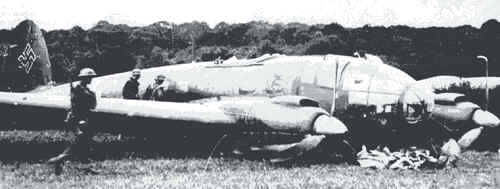The Heinkel He 111 was one of the primary bombers used by the Germans during the Blitz. The Heinkel 111 first flew in 1936 as an airliner for Lufthansa. However, while the civilian variety was capable of carrying ten passengers throughout Western Europe, a military version was also being developed. By 1937, the military version of the Heinkel 111 could carry 1700 kg of bombs, though later versions could carry over 2000 kg of bombs. As with so many new German planes, the 111 was tested out in the Spanish Civil War.
 A downed Heinkel 111 |
In the initial stages of the Battle of Britain, Hurricanes and Spitfires found that the 111 was an easy target if they could get amongst a bomber formation. Messerschmitt 109’s and 110’s were meant to give bomber formations protection, but if this shield was broken or if fighters low on fuel had to return to France, then the Heinkel 111 became a very vulnerable target.
During the Blitz on London, the 111 was used as a night bomber to give it some protection against the RAF. After the losses experienced during the Battle of Britain and the Blitz, the Heinkel 111 was used for other purposes. It developed more specialised roles such as a torpedo-carrier, a glider tug and a pathfinder. On the Russian front, the 111 was frequently used as a transport plane – especially in the Battle of Stalingrad. When the war ended, the 111 was being used almost exclusively as a transport plane.
More than 7,000 Heinkel He 111’s were built.
Facts:
Maximum speed: 227 mph (365 km/h) at sea level.
Ceiling: 21,980 feet (6,700 metres)
Range: 1,212 miles (1950 km)
Armament: 5 machine guns/cannon; 1000 kg of bombs.
Related Posts
- The Heinkel He 111 was one of the primary bombers used by the Germans during the Blitz. The Heinkel 111 first flew in 1936 as…